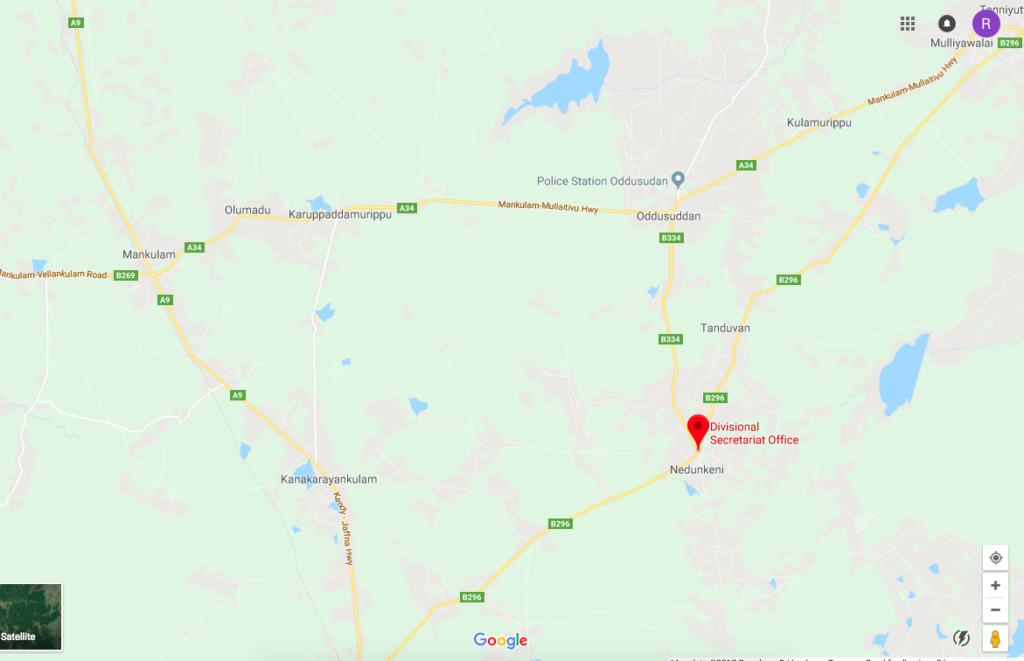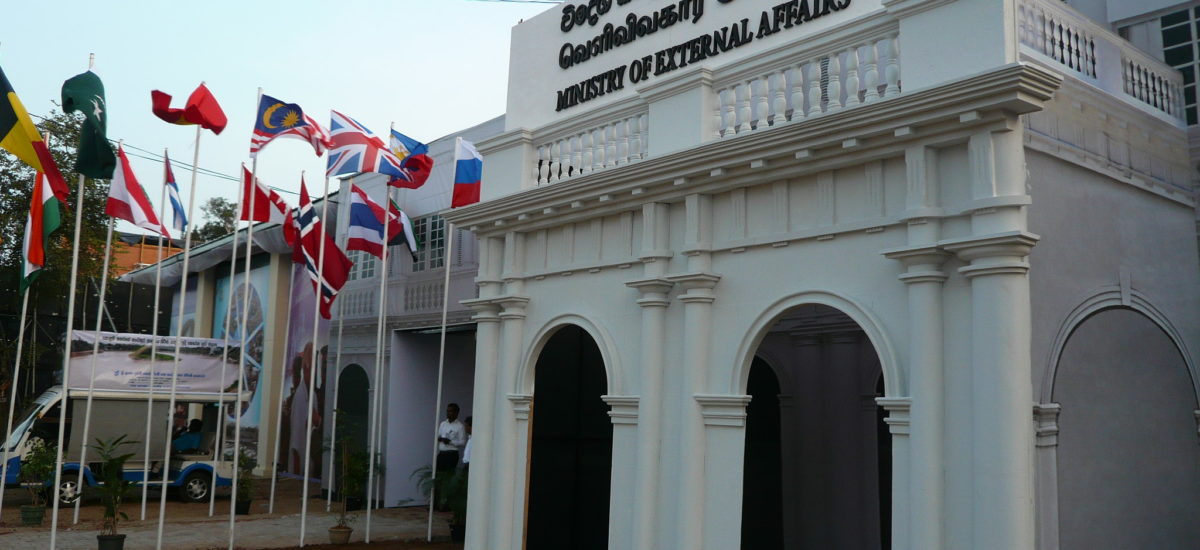Featured image courtesy NewsFirst
On November 24, two youth were questioned in Vavuniya around posts they had made on Facebook. One of the photos was of the Divisional Secretariat of Vavuniya North, Nandukerni, and specifically, a poster of a tree planting campaign.

The Nandukerni Divisional Secretariat office
Directly behind the poster was a large tree that looked as if it had been cut. The youth who posted the photo simply captioned it, “Vavuniya Divisional Secretariat”.
The response to this post was disturbing.
Police questioned 2 youth in Vavuniya about posting photos of DS office on Facebook. They were made to sign affidavit in Sinhala. Police said they could lose their jobs for taking photographs of Govt office. Caption only notes location. #lka #SriLanka pic.twitter.com/M06uqmi45r
— Groundviews (@groundviews) November 24, 2017
As confirmed by sister website Maatram and highlighted in the tweet above, the two youths were told by the Police that they could not critique the work of Government offices. They were told that they could lose their jobs in future, by posting such commentary, and made to sign an affidavit in Sinhala.
Surveillance and intimidation by the military are persistent problems in the North. However, this incident is of particular cause for concern.
To ridicule #lka police stupidity in questioning Northern youth who posted public office photos on #SocialMedia, let's ALL post such photos!
— Nalaka Gunawardene (@NalakaG) November 25, 2017
In response, Groundviews, together with Vikalpa in Sinhala and Maatram in Tamil, decided to post photos of Government offices in Colombo. The goal was to push back against the idea of monitoring social media and in particular the idea that the activities of the State should be exempt from criticism.
The photos were shared under a common hashtag #justaphotolka to make them easily searchable.
View the photos below:
Groundviews:
In Vavuniya, these photographs make you liable to questioning by the police https://t.co/q6DjrxYp5s #lka #SriLanka #justaphoto pic.twitter.com/5YBQyojUqi
— Groundviews (@groundviews) November 28, 2017
Vikalpa:
???????? ???????? ?????? ??????? ?????? ?????? ?????? ??????? ??? ?????? ??????? @SagalaRatnayaka
Pic @groundviews @MaatramSL#justaphotolk #arresthis #SriLanka #lka pic.twitter.com/ERiuQkLUj8— Vikalpa (@vikalpavoices) December 8, 2017
??? #Colombo #fort ?????????. ??? ?????? ??????. ??? ??????? ??????? ?????????? ????? ??? ???? ????????? ?? @SagalaRatnayaka @RWijewardene #justaphotolka #arrestthis @raisalw #RTIsl pic.twitter.com/rI64wOeJXz
— Vikalpa (@vikalpavoices) November 29, 2017
?????? ????????? ?? ???????/ ?????????? ??? ????? ?? ??????? ????? ?????? ???? ??????? #RTIsl ??? ??? ????? ??????? ???? ?????? ??????? ????? ????????? ??? ??? ?????? ?????????! #Vavuniya #srilanka #RTIsl @SagalaRatnayaka #justaphotolka #arrestthis Pic @raisalw pic.twitter.com/PLX454BDuS
— Vikalpa (@vikalpavoices) November 29, 2017
Maatram:
??? ????????????? ??????????? ???? ???? ???????????? ???? ??????????? ?????? ???????? ????????? https://t.co/ywfcIaDurR @SriLankaPolice2 @SagalaRatnayaka @MangalaLK #lka #srilanka #justaphotolka @groundviews @vikalpavoices @NalakaG @gopiharan @raisalw @sanjanah pic.twitter.com/rvoGvMkTUq
— Maatram (@MaatramSL) November 29, 2017
Following this, Vikalpa also filed an RTI request via registered post to the Vavuniya Divisional Secretariat, asking whether there was a law against photographing the Divisional Secretariat, and to cite the relevant Act under which photographing government offices was prohibited, if it did exist. The application is pending a reply as of the date of this article was published.
This is not the first incident involving members of the public being remanded for their photography – in September 2016, a 26-year-old was arrested for videoing the President’s helicopter when it landed. In November 2016, a man photographing VIP attendees at veteran musician Amaradeva’s funeral, held at Independence Square was also remanded and questioned for 3 days for “suspicious behaviour and pretending to be a journalist”. He was arrested on the orders of the Presidential Security Division, and underwent a psychological evaluation as well. More recently, in February this year, an Indian was arrested for taking photographs around Temple Trees, when it was decorated for Independence Day. It is, however, unique that the youths in Vavuniya were questioned based on their social media posts (implying a disturbing level of surveillance). It is revealing too that they chose not to explicitly criticise the office in their captions, but were still questioned anyway, indicating that the very act of photographing the office was prohibited.
Section 5(3) of the Official Secrets Act of 1955 does prohibit taking photographs, sketches of models of specified ‘prohibited places’. The term prohibited place however, refers to land, buildings or ships that have been specified by a Minister by Order. It is worth noting too that that the purpose of marking these areas as prohibited is “for the better safeguarding of information relating to the defence of Sri Lanka and to the equipment, establishment, organisation or institutions intended to be or capable of being used for the purpose of defence.” It is unclear whether Vavuniya Divisional Secretariat has been listed as a prohibited place as specified in the Act – but this question may be answered, should the Vavuniya Divisional Secretariat respond to Vikalpa’s RTI request on this score.
We encourage all interested to participate by tweeting photos of Government offices with the hashtag #justaphotolka, to push back against limitations to the freedom of expression.
Edittor’s Note: Also read “A Thousand Words: Seeking the story beyond the photo” and “Let the local discussion be your lodestar.”

